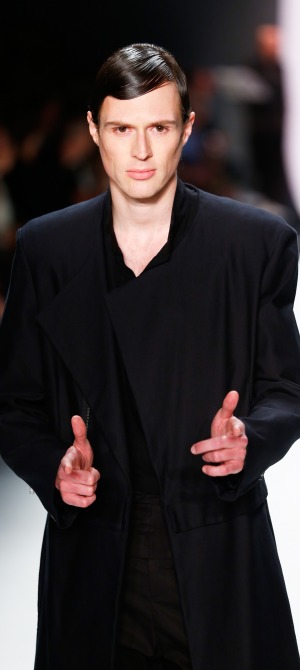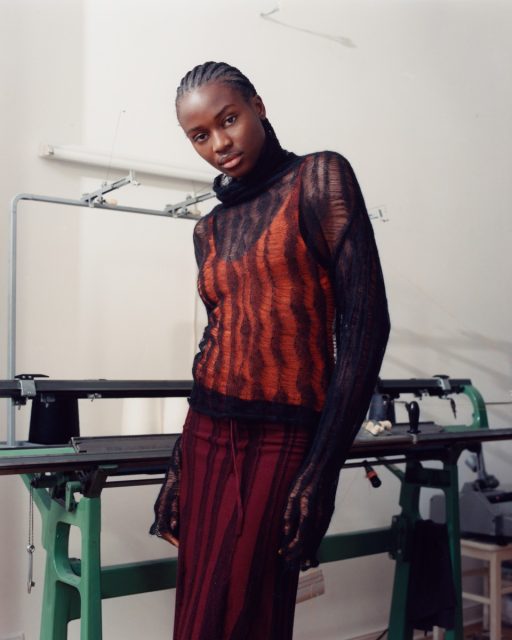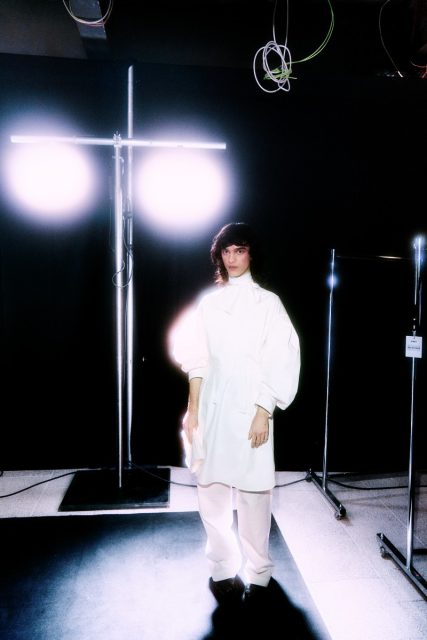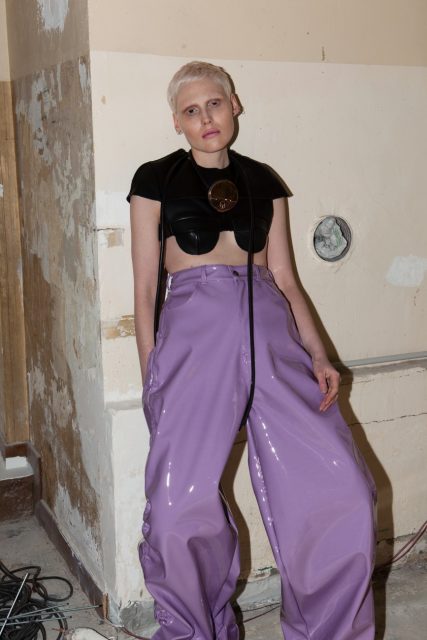
Perbandt (center) with Michael (L) and Rauber Photos by Birgit Kaulfuss

Female models sported faux mascara tear trails
Before Esther Perbandt’s show on Wednesday night, my only experience with opera was when I used to hide my mother’s Andrea Bocelli CD under our couch cushions to prevent her from playing “Con te Partiro” on repeat. Perbandt’s show on Wednesday, however, forced me to reconsider our relationship as singers Nadja Michael and Felix Rauber opened the show with a short operatic duet. Michael wore a long black Perbandt pantsuit with an enormous train and a tie. Perbandt’s show was theatrical to say the least. The designer showed 15 all black looks, 9 all white, and 16 black and white striped. The silhouettes for both men and women were slouchy and slinky. For men there were baggy, sheer crop tops, cut out suit jackets, and for women baggy jumpsuits, hot pants with long vests and structured maxi length sun dresses. The fabrics helped to create a defined structure for the pieces as they were sturdier linens and cottons. Each look solidly embodied Perbandt’s clarified aesthetic and while at times I found certain looks a bit pirate-y and heavy, it’s clear that Perbandt has considered each look and included it in her presentation to describe the aesthetic of her design universe.
After the show, I lined up backstage among many other writers who were anxious to talk with her. Despite my being one of many writers she had spoken with that night Perbandt was happy to talk about her work.
What was the idea behind this collection?
Well, the name of the collection is “Tears for the Impatient” and usually I actually start with a name not an idea. I’m myself very impatient and at the same time, somehow I’m the definition of slowness. I mean, I’ve been doing my label for eleven years and it’s really growing, very, very slowly and I really take my time, but I’m also so impatient.
How did you find or create the visuals for that idea?
Not at all. It doesn’t need to be connected for me. The seeds for my collection are very personal and very mental and then a collection comes with it.
What made you want to design in the first place?
That was pretty early for me. I was twelve when I decided I wanted to do it. When I was little we used to have this huge box with garments and I used to love to go through it and slipping into different characters and personalities.
What sort of characters are present in this collection?
Well actually I’m not really changing characters now. There’s this Esther Perbandt character. I’m always some how the center of the collections, you cannot separate them. It’s like it’s my universe and maybe each collection has a little bit of its own universe but it’s always part of this Esther Perbandt universe.
How have you formed that universe?
Oh it took me so much time to even find the handwriting. Maybe four years, but it’s been developing for eleven years. Now I feel like I have this base for it that I can build on.
When you design the clothes is there a way you imagine people wearing them?
I usually start with what do I want to wear? I’m always trying the samples and if I see it in the mirror I think yes, that’s right and if I feel it’s right I will make it.
How did you choose fabrics for this collection? Why did you choose mostly cotton and linen?
It’s ready to wear so people will wear it to work and want to be comfortable and I like basic fabrics and for summer it’s better. I prefer to focus on the cut, and the shapes and details than have very expensive fabrics. I am more interested in the construction.

Singer Dagobert walked the run way on Wednesday

Perbandt made this textile herself with a silk screen technique
Can you explain how you made that striped textile? Did you make it yourself?
Yes, I made it. It’s like a silkscreen with this sort of puff up paint. I really like how it goes on this very delicate fabric and sort of molds it and makes it sculptural so it becomes almost like an art piece.
Where are most things produced?
Mostly in Poland. We have a few we produce in the South in Bernau too.
Does being based in Berlin affect your aesthetic or your methods at all?
I have this funny quote in my press text that says: ‘born in Berlin, roughened in Moscow, and sharpened in Paris.’ So in Russia I became very inspired by the Russian Avant garde of the twenties and then in Paris of course I somehow got a very elegant aesthetic and so I think this mix is somehow my style. People say it’s New York as well, and I mean I would love to show this collection in New York.
How did you decide to work with the singers Nadja Michael and Felix Räuber?
It happened with the composer. He had right away the idea that we needed two singers very high and then one with a counter tenor and one male and one female to play with this subject of my work and also the black and white contrast in the collection.
Where are you hoping to be in five years as a designer?
I just hope I can continue to do these great big shows and co-operations with other artists and musicians because this is really what is more important for me than just the fashion, I need a lot of input from artists and intellectual people.

A black and white SS ’16 look

The male crop top made many appearances this fashion week, including on Herr Von Eden founder Bent Angelo Jensen




